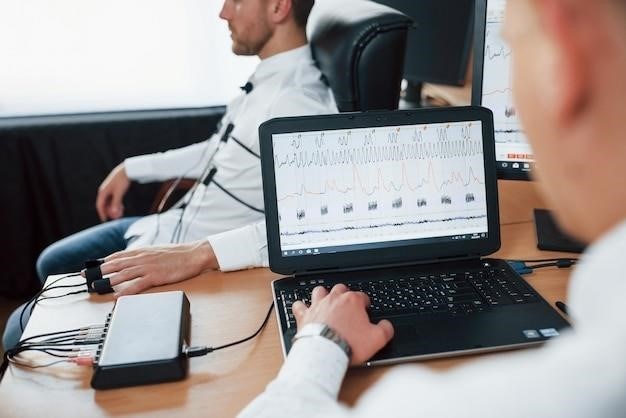holter monitor interpretation pdf

Holter Monitor Interpretation⁚ A Comprehensive Guide
This guide provides a comprehensive overview of Holter monitor interpretation, covering various aspects from the basic principles to advanced analysis techniques. It aims to equip healthcare professionals with the necessary knowledge to accurately interpret Holter monitor data and make informed clinical decisions.
Introduction to Holter Monitoring
Holter monitoring, also known as ambulatory electrocardiography (AECG), is a non-invasive diagnostic tool used to record and analyze the electrical activity of the heart over an extended period, typically 24 to 48 hours. It involves the use of a small, portable device, often referred to as a Holter monitor, which is worn by the patient and continuously records their heart rhythm. This continuous recording allows healthcare professionals to detect and assess various cardiac events, including arrhythmias, heart rate variability, and other abnormalities that may not be apparent during a standard electrocardiogram (ECG) performed in a doctor’s office.
Holter monitoring is a valuable diagnostic tool in cardiology, as it provides a more comprehensive picture of the heart’s electrical activity than a single ECG reading. It is particularly useful for identifying intermittent or infrequent cardiac events that may not be detected during a routine examination. The information gathered from a Holter monitor can help physicians diagnose and manage a wide range of heart conditions, including atrial fibrillation, ventricular tachycardia, bradycardia, and other arrhythmias, as well as assess the effectiveness of treatment strategies.
Understanding the principles of Holter monitoring, the types of data recorded, and the interpretation of findings is crucial for healthcare professionals involved in patient care. This guide aims to provide a comprehensive overview of Holter monitoring, covering its indications, procedures, data analysis, and clinical significance.
Indications for Holter Monitoring
Holter monitoring is indicated in a variety of clinical scenarios where a comprehensive assessment of heart rhythm is required. Its primary purpose is to detect and analyze cardiac events that may not be apparent during a standard ECG, particularly those that occur intermittently or infrequently. Some common indications for Holter monitoring include⁚
- Palpitations⁚ When a patient experiences episodes of heart palpitations, a Holter monitor can help identify the underlying cause, such as premature ventricular contractions (PVCs), atrial fibrillation, or other arrhythmias.
- Syncope (fainting)⁚ If a patient faints or experiences episodes of dizziness, a Holter monitor can help determine if the cause is related to a heart rhythm disturbance, such as bradycardia (slow heart rate) or ventricular tachycardia.
- Chest pain⁚ In cases of unexplained chest pain, Holter monitoring can help rule out or identify ischemic events, such as angina or silent ischemia, which may not be detected during a routine ECG.
- Evaluation of arrhythmias⁚ Holter monitoring is used to assess the frequency, duration, and characteristics of various arrhythmias, including atrial fibrillation, ventricular tachycardia, and bradycardia. This information helps guide treatment decisions.
- Monitoring treatment effectiveness⁚ Holter monitoring can be used to assess the effectiveness of antiarrhythmic medications or other treatments for heart rhythm disorders. It helps determine if the treatment is adequately controlling the arrhythmia or if adjustments are needed.
- Pre-operative evaluation⁚ Holter monitoring may be performed prior to surgery to identify any underlying heart rhythm abnormalities that could pose risks during the procedure.
The specific indications for Holter monitoring will vary depending on the individual patient and the suspected underlying condition.
Types of Holter Monitors
Holter monitors come in various forms, each offering unique advantages and limitations. The most common types include⁚
- Standard Holter Monitors⁚ These are traditional, portable devices that record the heart’s electrical activity continuously for 24 to 48 hours. They typically consist of a small, battery-powered recording unit worn around the waist or chest, and multiple electrodes attached to the skin. Standard Holter monitors provide a comprehensive overview of the heart rhythm over an extended period, allowing for the detection of both frequent and infrequent arrhythmias.
- Event Monitors⁚ These monitors are smaller and more compact than standard Holter monitors. They are designed to record the heart rhythm only when an event occurs, such as chest pain, palpitations, or dizziness. Event monitors are particularly useful for patients who experience infrequent or transient symptoms, as they minimize the duration of recording and reduce the inconvenience for the patient.
- Loop Recorders⁚ These devices are similar to event monitors but offer a longer recording duration. They can store a small amount of ECG data continuously and record a longer segment of data when an event is detected. Loop recorders are suitable for patients who experience infrequent but significant arrhythmias that may be missed by standard Holter monitors or event monitors.
- Smartwatch-based Holter Monitors⁚ Emerging technologies have integrated Holter monitoring capabilities into smartwatches. These devices can record the heart rhythm continuously or on demand, providing convenient and unobtrusive monitoring. However, it’s important to note that smartwatch-based Holter monitors may have limitations in terms of accuracy and data analysis compared to traditional devices.
The choice of Holter monitor type depends on the specific clinical indication, the patient’s symptoms, and the anticipated frequency and duration of the arrhythmia.
Procedure and Patient Instructions
The procedure for Holter monitoring is relatively straightforward and minimally invasive. Here’s a step-by-step overview of the process and the instructions typically provided to patients⁚
- Preparation⁚ Before the test, the patient will typically be asked to avoid using any lotions, oils, or creams on the skin where the electrodes will be placed. This ensures good electrical contact and minimizes interference with the recordings.
- Electrode Placement⁚ A trained healthcare professional will place multiple electrodes on the patient’s chest, arms, and legs. The electrodes are attached using adhesive pads and connected to the recording unit. The number and placement of electrodes may vary depending on the type of Holter monitor and the specific clinical indication.
- Recording Unit⁚ The patient will wear the recording unit, typically attached to a belt or carried in a pouch, for the prescribed duration, usually 24 to 48 hours. During this time, they are instructed to carry on with their normal daily activities, including work, exercise, and sleep.
- Symptom Diary⁚ Patients are often asked to keep a symptom diary during the monitoring period. This diary helps correlate any symptoms experienced, such as chest pain, palpitations, or dizziness, with the corresponding heart rhythm recordings. This diary is crucial for accurate interpretation of the Holter monitor data.
- Return and Data Analysis⁚ After the prescribed monitoring period, the patient will return to the healthcare provider to have the recording unit removed. The recorded data is then downloaded and analyzed by a cardiologist or other qualified healthcare professional.
Patients should be given clear and concise instructions on how to care for the Holter monitor during the monitoring period, including how to avoid interfering with the recording, how to handle the recording unit, and how to report any unusual symptoms or events.
Common Findings and Interpretation
Holter monitor recordings can reveal a wide range of cardiac abnormalities, providing valuable insights into a patient’s heart rhythm and electrical activity. Here are some of the most common findings and their interpretations⁚
- Atrial Fibrillation (AFib)⁚ A common type of irregular heartbeat characterized by rapid and chaotic electrical activity in the atria. AFib can lead to symptoms like palpitations, shortness of breath, and fatigue. On a Holter monitor, AFib appears as a chaotic, irregular rhythm with no discernible P waves.
- Premature Ventricular Complexes (PVCs)⁚ Extra heartbeats that originate in the ventricles, often causing a feeling of skipped beats. PVCs can be benign or indicative of underlying heart disease. On a Holter monitor, PVCs appear as wide, distorted QRS complexes that are premature and different from the normal heart rhythm.
- Bradycardia⁚ A slow heart rate, usually defined as less than 60 beats per minute. Bradycardia can be normal in some individuals, but it can also be a sign of heart block or other problems. On a Holter monitor, bradycardia is characterized by a slow, regular rhythm.
- Tachycardia⁚ A fast heart rate, usually defined as greater than 100 beats per minute. Tachycardia can be caused by a variety of factors, including exercise, anxiety, and heart disease. On a Holter monitor, tachycardia is characterized by a fast, regular rhythm.
- Ischemia⁚ A condition where the heart muscle is not receiving enough oxygen, often due to narrowed coronary arteries. Ischemia can cause chest pain (angina) and other symptoms. On a Holter monitor, ischemia may be indicated by ST segment depression or T wave inversion.
Interpreting Holter monitor findings requires careful analysis by a trained healthcare professional. Factors such as the frequency, duration, and pattern of the abnormalities, as well as the patient’s symptoms and medical history, are all considered in making a diagnosis.
Analyzing Holter Monitor Data
Analyzing Holter monitor data involves a systematic approach to identify and interpret cardiac abnormalities. The process typically involves several steps⁚
- Data Acquisition⁚ The Holter monitor records the patient’s heart rhythm continuously for 24 or 48 hours. The data is stored on a small memory card or transmitted wirelessly to a secure server.
- Data Download and Review⁚ Once the recording is complete, the data is downloaded onto a computer for analysis. A specialized software program is used to visualize the ECG waveforms and identify any abnormalities.
- Rhythm Analysis⁚ The software analyzes the heart rhythm to identify any episodes of arrhythmia, such as atrial fibrillation, premature ventricular contractions, or bradycardia. It also calculates the patient’s average heart rate and heart rate variability.
- ST Segment Analysis⁚ The software can analyze the ST segment of the ECG to detect signs of ischemia, which is a condition where the heart muscle is not receiving enough oxygen. This analysis is particularly important for patients with known coronary artery disease.
- Event Correlation⁚ The software allows the clinician to correlate the ECG findings with the patient’s symptom diary. This helps to determine if the ECG abnormalities are associated with the patient’s symptoms.
Holter monitor data analysis is a complex process that requires expertise and experience. Clinicians must consider the patient’s medical history, symptoms, and other relevant factors to interpret the findings accurately.
Reporting Holter Monitor Results
The interpretation of Holter monitor results is essential for guiding clinical decision-making. A comprehensive report should include the following key elements⁚
- Patient Demographics⁚ Basic information about the patient, such as name, age, gender, and medical history, should be included.
- Recording Parameters⁚ Details about the recording period, the type of monitor used, and the number of leads should be documented.
- Rhythm Analysis⁚ A detailed description of the patient’s heart rhythm, including the presence or absence of arrhythmias, their frequency, duration, and morphology.
- ST Segment Analysis⁚ Any ST segment abnormalities, including their location, duration, and relationship to symptoms, should be reported.
- Event Correlation⁚ A summary of the patient’s symptom diary and how it relates to the ECG findings.
- Overall Interpretation⁚ A concise interpretation of the findings, highlighting the most significant abnormalities and their clinical implications.
- Recommendations⁚ Specific recommendations for further evaluation or management based on the Holter monitor results.
The Holter monitor report should be written in a clear and concise manner, using standardized terminology and avoiding technical jargon. It should be tailored to the specific needs of the referring physician and the patient;
Limitations of Holter Monitoring
While Holter monitoring is a valuable tool for diagnosing and managing cardiac arrhythmias, it has several limitations that should be considered⁚
- Limited Recording Duration⁚ Holter monitors typically record for 24-48 hours, which may not capture infrequent or transient events.
- Patient Compliance⁚ Accurate interpretation of Holter monitor data relies on patient compliance in maintaining the monitor and keeping an accurate symptom diary. Patient forgetfulness or lack of awareness of symptom correlation can limit the usefulness of the recording.
- Artifact Interference⁚ Artifacts from movement, electrical interference, or poor electrode placement can distort the ECG signal and make interpretation challenging.
- Limited Diagnostic Value⁚ Holter monitoring is not always sensitive enough to detect subtle or infrequent arrhythmias, especially in patients with a low burden of events.
- Lack of Hemodynamic Information⁚ Holter monitors provide information about heart rhythm but do not capture hemodynamic parameters like blood pressure or cardiac output.
- Cost and Accessibility⁚ Holter monitoring can be expensive, and access to the technology may be limited in some settings.
Understanding these limitations is crucial for interpreting Holter monitor results and avoiding misdiagnosis or inappropriate treatment decisions.
Holter Monitoring in Specific Populations
Holter monitoring plays a crucial role in the management of cardiac arrhythmias in various patient populations. Here are some specific examples⁚
- Patients with Syncope⁚ Holter monitoring can help identify the underlying cause of syncope (fainting), such as bradycardia (slow heart rate), tachycardia (fast heart rate), or other arrhythmias.
- Patients with Palpitations⁚ Holter monitoring can detect the presence and frequency of palpitations, allowing for better characterization and management of the underlying arrhythmia.
- Patients with Suspected Ischemia⁚ Holter monitoring can help identify silent myocardial ischemia (heart muscle damage without chest pain), which may be a sign of underlying coronary artery disease.
- Patients with Pacemakers or Defibrillators⁚ Holter monitoring can assess pacemaker or defibrillator function, detect problems with device performance, and identify potential device-related arrhythmias.
- Athletes⁚ Holter monitoring can help assess the presence of arrhythmias in athletes, particularly those with symptoms of palpitations or dizziness during exercise.
- Patients with Congenital Heart Disease⁚ Holter monitoring can monitor for arrhythmias and other cardiac abnormalities in patients with congenital heart disease, especially during periods of stress or exercise.

In these populations, Holter monitoring provides valuable information for diagnosis, risk stratification, and treatment decisions.



Leave a Reply
You must be logged in to post a comment.